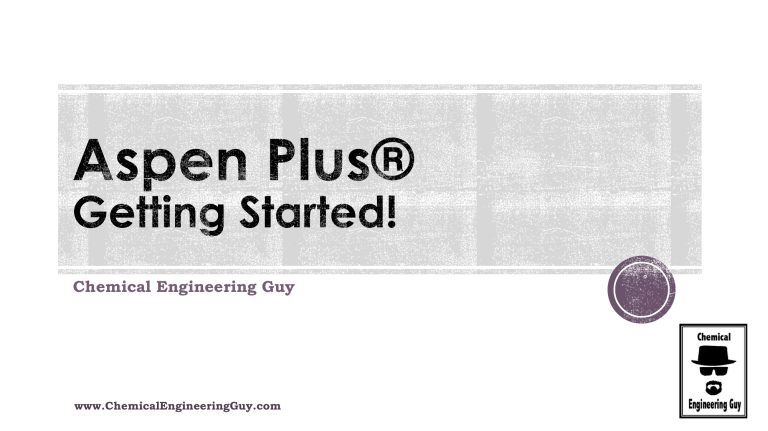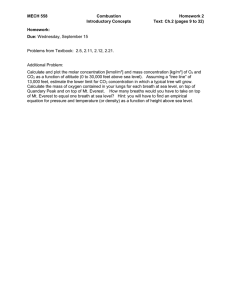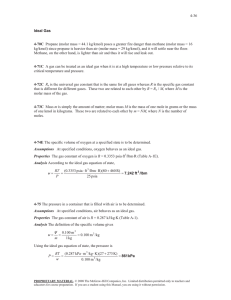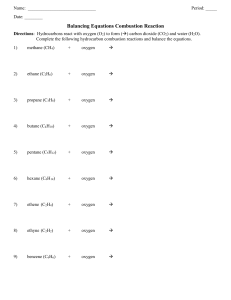
Chemical Engineering Guy www.ChemicalEngineeringGuy.com Change: • • • • • • • All T of Reactors Feed Composition No. of Plates in Distl. Col T of Heat Ex Gas Sep. T Compressor P Utility Costs www.ChemicalEngineeringGuy.com www.ChemicalEngineeringGuy.com ▪ Makes us easier/faster work ▪ Multiple and Simultaneous Simulations ▪ Different Real-Life Scenarios ▪ Change on raw/feed materials scenario ▪ Pricing and Costs calculation ▪ Raw Materials ▪ Plant Cost ▪ Utilities ▪ How it would behave under different conditions ▪ High/Low Pressure ▪ Humidity Changes ▪ Temperature change (cool/warm days/seasons) www.ChemicalEngineeringGuy.com ▪ Mainly: ▪ Petrochemical ▪ Pharmaceutical ▪ Fine chemicals ▪ Other commodities such as: ▪ Sulfuric acids ▪ Chlorine/Caustic industry ▪ Solvents ▪ Coatings ▪ Many more… www.ChemicalEngineeringGuy.com ▪ Excelent for your curriculum as an engineer ▪ Perfect for analytical/numerical minds ▪ Good for debuging and fixing “what if” scenarios www.ChemicalEngineeringGuy.com 1. Introduction 2. Our Chemical Process! 3. Setting up the Physical Property Environment 4. Simulation Environment I – The Flowsheet 5. Simulation Environment II – Unit Operations 6. Running, Results & Analysis 7. Case Studies (A,B,C,D) 8. Conclusion www.ChemicalEngineeringGuy.com ▪ Introductory Knowledge of Processes Modeling ▪ Setting the adequate Physical Properties ▪ General Flowsheet Concepts ▪ Basic Flowsheet “manipulation” ▪ Common Unit Operations ▪ Minimum Requirements to set up & run a Simulation ▪ Analyze several changes in process conditions ▪ Create an interest in Process Modeling www.ChemicalEngineeringGuy.com ▪ Please contact me if required (doubts, questions, comments, suggestions) ▪ Contact@ChemicalEngineeringGuy.com ▪ More courses… www.ChemicalEngineeringGuy.com www.ChemicalEngineeringGuy.com www.ChemicalEngineeringGuy.com ▪ Unit Operations ▪ Heat Exchange ▪ Heat Exchanger ▪ Reaction Kinetics ▪ Combustion Chamber / Reactor ▪ Momentum ▪ Pump ▪ Compressor ▪ Separation Process ▪ Flash Drum ▪ Distillation Columns www.ChemicalEngineeringGuy.com ▪ A hydrocarbon feed rich in aromatics is to be separated via a series of separation processes. ▪ It is sent from a previous plant at ambient temperature (15°C) and pressurized to 10 bar. ▪ A total of 100 kmol/h must be treated ▪ Most of the hydrocarbons msut be recovered and the leftovers will be burnt in a combustion chamber. ▪ The combustion chamber will burn all hydrocarbons to form carbon dioxide. Assume 100% combustion. The air for combustion was previously adjusted to 50°C, 10bar. There is no pression loss in the combustion chamber. ▪ The liquified section must be de-pressurized in order to continue treatment. It drops to 2 bar via a valve. www.ChemicalEngineeringGuy.com ▪ This stream is then fed to a Distillation Column. ▪ It currently has a total of 15 trays. ▪ Feed tray must be between 7 and 8. ▪ Recommended operation is partial vapor in order to avoid an extra stage. Reflux ▪ Ratio is set to 5 (molar) and the approx. ▪ Pressure drop is unknown, but can be assumed to be low or negligible. ▪ At least 20% of the feed must be recovered for further treatment ▪ The Distillate is to be treated in a following process. It must be compressed to 5 bar. We use a compressor with approx. 88% efficiency. It can be modeled as an isentropic compression. www.ChemicalEngineeringGuy.com ▪ The bottoms of this column are not pure enough. Further distillation is required. ▪ The following column requires a total of: ▪ 20 trays feeding in 50% approx. ▪ It uses a total condenser since the distillate is required as a liquid ▪ Recommended Distillate recovery is 60% ▪ Reflux is set to 4 molar ▪ The pressure drop is unkown, but current process has: ▪ Condenser working ate 1.90 bar ▪ Reboiler working at 2.10 bar ▪ The distillate can be sent for storage ▪ The bottom must be further pressurized +0.5 bar in order to allow for pressure drop due to frictions. Efficiency of pump is 66.7% www.ChemicalEngineeringGuy.com ▪ Requirements: ▪ Model the plant using Aspen Plus in Steady State ▪ Verify Material/Energy Balances of the unit operations & processes ▪ Verify purity and composition of streams ▪ Verify conditions such as T, P and Flow rates. ▪ For specific unit operations, verify their relevant results ▪ Heater → Heat duty ▪ Combustion Chamber → T-max, Heat released by reaction ▪ Compressor/Pump → Required Work ▪ For the Columns → Reboiler & Condenser Duties www.ChemicalEngineeringGuy.com ▪ Unit Operations ▪ Heat Exchange ▪ Heat Exchanger ▪ Reaction Kinetics ▪ Combustion Chamber / Reactor ▪ Momentum ▪ Pump ▪ Compressor ▪ Separation Process ▪ Flash Drum ▪ Distillation Columns www.ChemicalEngineeringGuy.com ▪ Pipes www.ChemicalEngineeringGuy.com ▪ Flash Tank: www.ChemicalEngineeringGuy.com ▪ Combustion Chamber / Reactor www.ChemicalEngineeringGuy.com ▪ Distillation Columns www.ChemicalEngineeringGuy.com ▪ Compressor & Pump www.ChemicalEngineeringGuy.com ▪ PDF of Process diagram ▪ Spreadsheet with Unit Operations & Process conditions ▪ Spreadsheet with Component list & database www.ChemicalEngineeringGuy.com ▪ Landing Page www.ChemicalEngineeringGuy.com ▪ Min. Requirements: ▪ Adding Components to the Component List ▪ Selecting a Physical Property Method (Thermodynamic pack) ▪ If you want to further explore this environment → ▪ Aspen Plus - Physical Properties ▪ Different Types of Components ▪ Methods (EOS, Activity, Mixed) ▪ Modeling new/inexistent components ▪ Physical & Chemical Property Analysis ▪ Thermodynamic & Transport Properties www.ChemicalEngineeringGuy.com ▪ Add the following compounds to the “Component List” ▪ Methane ▪ Ethane ▪ Propane ▪ N-Butane ▪ Cyclohexane ▪ Benzene ▪ Toluene ▪ Oxygen ▪ Nitrogen www.ChemicalEngineeringGuy.com ▪ Select Peng Robinson, as it is mostly non-polar system ▪ Most models will be “set-up” ▪ Pure substances Properties will be loaded ▪ Binary Interactions are calculated ▪ Tip: Use the Method Assistant www.ChemicalEngineeringGuy.com www.ChemicalEngineeringGuy.com www.ChemicalEngineeringGuy.com ▪ Get to know what is a flowsheet and how to manipulate it. ▪ Menus, Tool, Areas, etc… ▪ Important: ▪ General Setup ▪ Blocks: Unit Operations, Others ▪ Streams (Material, Heat, Work) ▪ Analysis tools www.ChemicalEngineeringGuy.com ▪ Manipulation of the Flowsheet: ▪ Adding Unit Operations ▪ Adding Material and Energy streams ▪ Moving ▪ Labeling ▪ Rotating ▪ Deleting ▪ Copy and Pasting www.ChemicalEngineeringGuy.com ▪ Typical Unit Operations ▪ Adding UO ▪ Setting up ▪ Connecting streams ▪ Inlet/outlet www.ChemicalEngineeringGuy.com ▪ A hydrocarbon feed rich in aromatics is to be separated via a series of separation processes. ▪ It is sent from a previous plant at ambient temperature (15°C) and pressurized to 10 bar. ▪ A total of 100 kmol/h must be treated ▪ Most of the hydrocarbons msut be recovered and the leftovers will be burnt in a combustion chamber. ▪ The combustion chamber will burn all hydrocarbons to form carbon dioxide. Assume 100% combustion. The air for combustion was previously adjusted to 50°C, 10bar. There is no pression loss in the combustion chamber. ▪ The liquified section must be de-pressurized in order to continue treatment. It drops to 2 bar via a valve. www.ChemicalEngineeringGuy.com ▪ This stream is then fed to a Distillation Column. ▪ It currently has a total of 15 trays. ▪ Feed tray must be between 7 and 8. ▪ Recommended operation is partial vapor in order to avoid an extra stage. Reflux ▪ Ratio is set to 5 (molar) and the approx. ▪ Pressure drop is unknown, but can be assumed to be low or negligible. ▪ At least 20% of the feed must be recovered for further treatment ▪ The Distillate is to be treated in a following process. It must be compressed to 5 bar. We use a compressor with approx. 88% efficiency. It can be modeled as an isentropic compression. www.ChemicalEngineeringGuy.com ▪ The bottoms of this column are not pure enough. Further distillation is required. ▪ The following column requires a total of: ▪ 20 trays feeding in 50% approx. ▪ It uses a total condenser since the distillate is required as a liquid ▪ Recommended Distillate recovery is 60% ▪ Reflux is set to 4 molar ▪ The pressure drop is unkown, but current process has: ▪ Condenser working ate 1.90 bar ▪ Reboiler working at 2.10 bar ▪ The distillate can be sent for storage ▪ The bottom must be further pressurized +0.5 bar in order to allow for pressure drop due to frictions. Efficiency of pump is 66.7% www.ChemicalEngineeringGuy.com ▪ Requirements: ▪ Model the plant using Aspen Plus in Steady State ▪ Verify Material/Energy Balances of the unit operations & processes ▪ Verify purity and composition of streams ▪ Verify conditions such as T, P and Flow rates. ▪ For specific unit operations, verify their relevant results ▪ Heater → Heat duty ▪ Combustion Chamber → T-max, Heat released by reaction ▪ Compressor/Pump → Required Work ▪ For the Columns → Reboiler & Condenser Duties www.ChemicalEngineeringGuy.com ▪ Unit Operations ▪ Heat Exchange ▪ Heat Exchanger ▪ Reaction Kinetics ▪ Combustion Chamber / Reactor ▪ Momentum ▪ Pump ▪ Compressor ▪ Separation Process ▪ Flash Drum ▪ Distillation Columns www.ChemicalEngineeringGuy.com www.ChemicalEngineeringGuy.com ▪ Feed ▪ F = 100 kmol/h ▪ T = 15°C ▪ P = 10 bar ▪ Comp: ▪ Toluene ▪ Benzene ▪ Cyclohex ▪ Butane ▪ Propane ▪ Methane ▪ Ethane 0.190 0.200 0.120 0.110 0.075 0.150 0.155 www.ChemicalEngineeringGuy.com ▪ Air ▪ ▪ ▪ ▪ F = 1200 kmol/h T = 50°C P = 10 bar Comp: ▪ 0.79 N2 ▪ 0.21 O2 ▪ Heater ▪ T = 40°C ▪ dP = 0 bar ▪ P = 10 bar www.ChemicalEngineeringGuy.com ▪ Flash2 ▪ Q=0 ▪ T = 40°C ▪ P = 10 bar ▪ dP = 0 bar www.ChemicalEngineeringGuy.com ▪ Valve ▪ P = 2 bar www.ChemicalEngineeringGuy.com ▪ RadFrac ▪ Stages = 15 ▪ Feed = 8 ▪ Cond = Partial ▪ D-Rate = 20 kmol/h ▪ Reflux = 5 molar ▪ P-reboiler = 1.95 bar www.ChemicalEngineeringGuy.com ▪ RadFrac ▪ Stages = 15 ▪ Feed = 8 ▪ Cond = Partial ▪ D-Rate = 20 kmol/h ▪ Reflux = 5 molar ▪ P-reboiler = 1.95 bar www.ChemicalEngineeringGuy.com ▪ RadFrac ▪ Stages = 15 ▪ Feed = 8 ▪ Cond = Partial ▪ D-Rate = 20 kmol/h ▪ Reflux = 5 molar ▪ P-reboiler = 1.95 bar www.ChemicalEngineeringGuy.com ▪ RadFrac ▪ Stages = 15 ▪ Feed = 8 ▪ Cond = Partial ▪ D-Rate = 20 kmol/h ▪ Reflux = 5 molar ▪ P-reboiler = 1.95 bar www.ChemicalEngineeringGuy.com ▪ RadFrac ▪ Stages = 15 ▪ Feed = 8 ▪ Cond = Partial ▪ D-Rate = 20 kmol/h ▪ Reflux = 5 molar ▪ P-reboiler = 1.95 bar www.ChemicalEngineeringGuy.com ▪ RadFrac ▪ Stages = 15 ▪ Feed = 8 ▪ Cond = Partial ▪ D-Rate = 20 kmol/h ▪ Reflux = 5 molar ▪ P-reboiler = 1.95 bar www.ChemicalEngineeringGuy.com ▪ Distil ▪ Stages = 20 ▪ Feed = 10 ▪ Cond = Total ▪ D:F Ratio = 0.60 ▪ Reflux = 4 molar ▪ P-cond = 1.90 bar ▪ P-reboiler = 2.10 bar www.ChemicalEngineeringGuy.com ▪ Compr ▪ Type = Isentropic ▪ Eff = 88% ▪ P-final = 5 bar www.ChemicalEngineeringGuy.com ▪ Pump ▪ Type = Isentropic ▪ Eff = 66.7% ▪ P-increse = 0.5 bar www.ChemicalEngineeringGuy.com ▪ RSTOIC ▪ Type = Stoichiometry ▪ Q=0 ▪ P = 10 bar ▪ dP = 0 bar www.ChemicalEngineeringGuy.com ▪ RXN ▪ CH4 + 2O2 = CO2 + 2H2O ▪ C2H6 + 7O2 = 4CO2 + 6H2O ▪ C3H8 + 5O2 = 3CO2 + 4H2O ▪ 2C4H10 + 13O2 = 8CO2 + 10H2O ▪ C6H12 + 6O2 = 3CO2 + 6H2O ▪ 2C6H6 + 15O2 = 12CO2 + 6H2O ▪ C7H8 + 9O2 = 7CO2 + 4H2O www.ChemicalEngineeringGuy.com www.ChemicalEngineeringGuy.com ▪ Running the simulation ▪ Errors & Debugging ▪ Getting Results ▪ Stream Results ▪ Block Results ▪ Analysis ▪ What if Scenarios www.ChemicalEngineeringGuy.com ▪ Error Messages www.ChemicalEngineeringGuy.com www.ChemicalEngineeringGuy.com www.ChemicalEngineeringGuy.com www.ChemicalEngineeringGuy.com ▪ Manual “what if” cases ▪ Change several inputs to get new outputs ▪ Change of T Heat ▪ Change of P valve ▪ Change of P Reactor ▪ Changer of Reflux Dist1 ▪ Change of Stages Dist2 www.ChemicalEngineeringGuy.com ▪ Compare your results with mine: www.ChemicalEngineeringGuy.com ▪ Change T = 40°C to T = 30°C of Heater www.ChemicalEngineeringGuy.com ▪ Change Pressure of Valve ▪ P = 1 bar ▪ P = 5 bar No Drastic Change www.ChemicalEngineeringGuy.com ▪ Change Pressure of Reactor ▪ P = -5bar ▪ P = 1bar www.ChemicalEngineeringGuy.com ▪ Change Reflux Ratio from 4 to 2 and/or 6 and/or 15 www.ChemicalEngineeringGuy.com 1. Introduction 2. Our Chemical Process! 3. Setting up the Physical Property Environment 4. Simulation Environment I – The Flowsheet 5. Simulation Environment II – Unit Operations 6. Running, Results & Analysis 7. Case Studies 8. Conclusion www.ChemicalEngineeringGuy.com ▪ Introductory Knowledge of Processes Modeling ▪ General Flowsheet Concepts ▪ Setting the adequate Physical Properties ▪ Basic Flowsheet “manipulation” ▪ Minimum Requirements to set up & run a Simulation ▪ Common Unit Operations ▪ Create an interest in Process Modeling www.ChemicalEngineeringGuy.com Change: • • • • • • • All T of Reactors Feed Composition No. of Plates in Distl. Col T of Heat Ex Gas Sep. T Compressor P Utility Costs www.ChemicalEngineeringGuy.com ▪ Typically, you will follow your training with ▪ Basic Course ▪ What do you learn there: ▪ More on Aspen Plus ▪ More on Physical Property Environment ▪ Flowsheet techniques ▪ More Unit Operations ▪ Analysis Tools ▪ Plenty Workshops ▪ Process & Industry Case Studies www.ChemicalEngineeringGuy.com ▪ Aspen Plus – Basic Course! ▪ 1 Month Free Trial then $8.00 USD/month www.ChemicalEngineeringGuy.com ▪ Aspen Plus – Training Bundle includes: ▪ Aspen Plus – Getting Started ▪ Aspen Plus – Basic Course ▪ Aspen Plus – Physical Properties ▪ Aspen Plus – Intermediate Course ▪ Aspen Plus – Boot camp: 12 Case studies ▪ All other new upcoming Aspen Plus courses www.ChemicalEngineeringGuy.com




